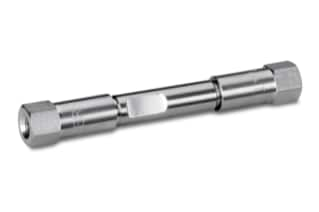
|
Chemistry |
C18 |
|
Separation Mode |
Reversed Phase |
|
Particle Substrate |
Silica |
|
pH Range Min |
2 pH |
|
pH Range Max |
8 pH |
|
Maximum Pressure |
6000 psi (415 Bar) |
|
Endcapped |
Yes |
|
Silanol Activity |
Low |
|
Particle Shape |
Spherical |
|
Particle Size |
3.5 µm |
|
Endfitting Type |
Waters |
|
Pore Size |
100 Å |
|
Format |
Column |
|
Surface Area |
335 |
|
System |
HPLC |
|
USP Classification |
L1 |
|
Inner Diameter |
4.6 mm |
|
Length |
50 mm |
|
Carbon Load |
19 % |
|
UNSPSC |
41115709 |
|
Brand |
Symmetry |
|
Product Type |
Columns |
|
Units per Package |
1 pk |

Symmetry C18 Column, 100Å, 3.5 µm, 4.6 mm X 50 mm, 1/pk
Maximize the efficiency and precision in your lab using the Symmetry C18 Column. The monofunctional bonded C18 ligand that is used in the manufacture of the Symmetry C18 Column in combination with the high purity base-deactivated silica, makes it possible for the lab equipment to offer unmatched reproducibility. The Symmetry C18 Column also has the narrowest ligand surface coverage (ligand density) specifications in the industry, resulting in minimal shifts in resolution and more reproducible batch-to-batch results. Hence, with the Symmetry C18 Column, you achieve outstanding reproducibility year on year.
No need to continuously revalidate and redevelop methods with each batch of new columns. The column makes it possible to save labor costs that accumulate with the traditional analytical columns that require QC column testing.
By engineering the Symmetry C18 Column with high purity raw materials and column packing procedures that result in the most reproducible HPLC column, it is assured that you will only receive quality equipment for your lab. Additionally, the Symmetry C18 Column is also accompanied by a three-page Certificate of Analysis which contains the specifications as well as the results of 22 critical tests that each column needs to clear before being quality assured.
If you have any queries or concerns regarding any of our products, you can refer to our website that contains information regarding our offices around the world. From there, you can reach out to a member of our staff to address your concern. In addition to this, the website enables you to shop for lab equipment directly from us.
You may also be interested in the Reversed-Phase QC Reference Material, a unique collection of standards and mixtures that are challenging to separate and can be used with a variety of column chemistries and dimensions, and systems hardware. Containing 7 compounds including uracil, butylparaben, naphthalene, propranolol, dipropyl phthalate, acenaphthene, and amitriptyline at pH 7, the reference material is used to benchmark your system before conducting any crucial analysis.
How Is Column Equilibration Done On The Symmetry C18 Column?
Before column equilibration is done, it is important to ensure mobile phase compatibility before changing to another mobile phase system. Equilibrate the column with a minimum of 10 column volumes of the mobile phase to be used. To avoid precipitating out mobile phase buffers on your column, or in the system, flush the column with five column volumes of a water/organic solvent mixture, using the same or lower solvent content as in the desired buffered mobile phase. 100-200 column volumes may be required for complete equilibration if mobile phase additives are present in low concentrations. Additionally, formate containing mobile phases may also require longer initial column equilibration times.